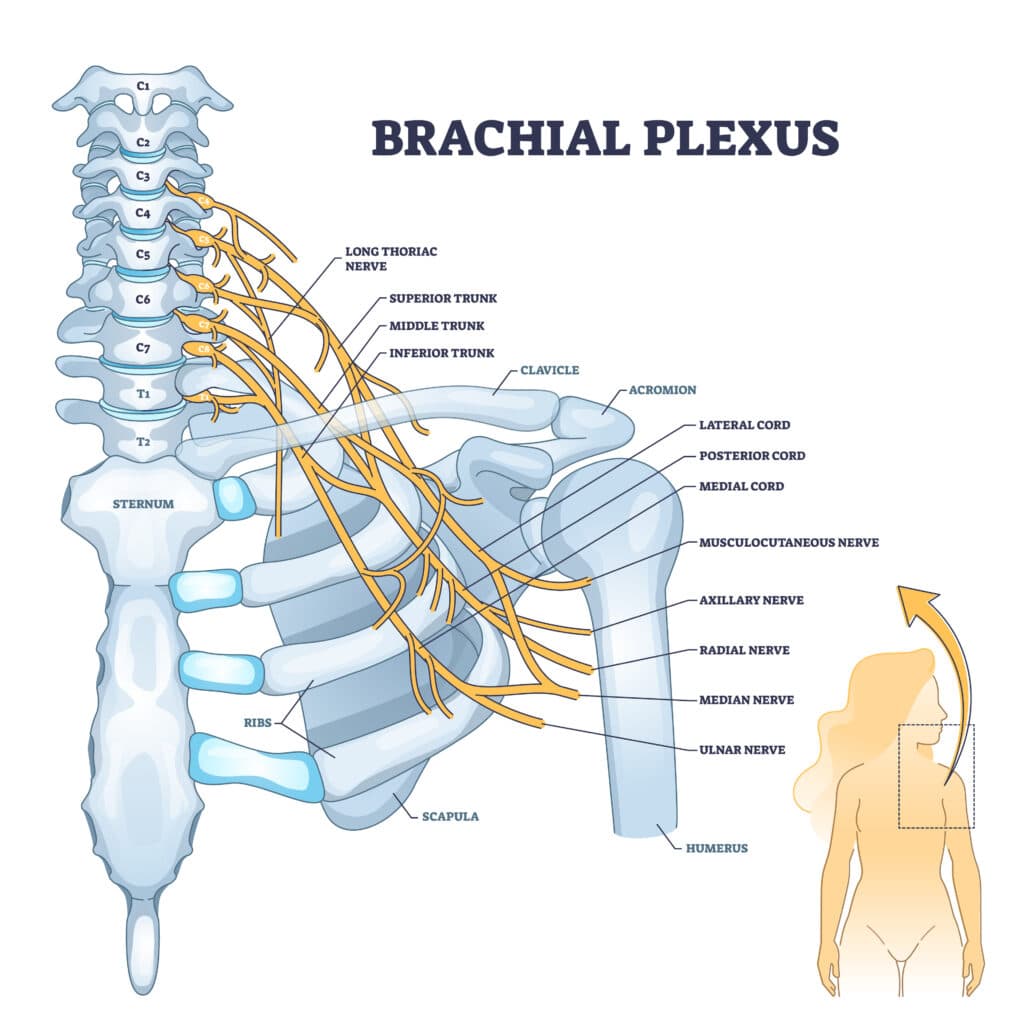Have you ever experienced a sharp, shooting pain radiating down your arm or felt tingling and numbness in your fingers? If so, you might be experiencing a pinched nerve in the shoulder joint.
Identifying the source of this discomfort and how to fix it is essential, but it’s only possible with the proper knowledge, tools, and some helpful guidance.
In this article I’ll provide insights from a physical therapist’s perspective about what causes this common problem and how you can find relief.
What Is a Pinched Nerve?

Before we discuss the specifics of pinched nerves in the shoulder, let’s first understand what a pinched nerve is.
When you have a pinched nerve, undue pressure or compression on a nerve in your body disrupts its normal function. To better grasp this concept, I usually tell my patients to imagine their nerves as intricate electrical cables. These cables transmit signals between their brains and the various parts of their bodies.
These signals control everything from muscle movement to sensation and pain perception. However, when one of these cables becomes compressed or “pinched” due to pressure from surrounding tissues like muscles, tendons, or bones, it’s akin to crimping a hose or kinking a wire.
How Does Compression Cause Nerve Pain?
This compression interferes with the nerve’s ability to transmit signals effectively. This may lead to shooting pain, tingling, numbness, or weakness in the affected area. Essentially, a pinched nerve disrupts the smooth flow of communication between your brain and the rest of your body, resulting in discomfort and dysfunction.
Essentially, the signals traveling along the nerve fibers can become “stuck” or disrupted, resulting in a buildup of electrical activity. This buildup of activity can manifest as a sharp, shooting pain radiating outward from the compression site. The closer you get to the source of the compression, the more intense the pain may feel.
Additionally, because nerves often branch out and connect to wide-ranging areas of the body, the pain can radiate along these pathways, leading to sensations of discomfort or numbness in distant regions.
Which Nerves Are Near the Shoulder?

Several nerves are located near the shoulder, playing crucial roles in controlling movement and sensation in the upper extremity. Some critical nerves near the shoulder include the axillary, musculocutaneous, radial, median, and ulnar nerve.
A Primer on Neck and Shoulder Nerves
My patients often benefit from a basic understanding of each of these nerves since it can help them self-identify where their issue is coming from. These nerves work together to facilitate movement and sensation in the shoulder, arm, and hand, playing integral roles in everyday activities and motor functions.
Here’s a simple breakdown:
- The axillary nerve goes to the outer shoulder area.
- The musculocutaneous nerve controls your bicep muscle.
- The radial nerve controls your triceps, wrist extensors, and finger extensors and sensation to the entire palm of your hand besides the pinky.
- The ulnar nerve controls the wrist and finger flexors and the sensation in the pinky finger and half the ring finger.
It’s important to remember not to self-diagnose, as a medical professional will know best which nerve you’re having issues with. However, this information can be helpful to narrow down which of your nerves is “pinched” and where it might be compressed, depending on where you are losing sensation and/or strength.1
They all stem from a complex web of neural tissue called the brachial plexus, located between the chest and shoulder.
The Brachial Plexus: Your Arm and Shoulder’s Nerve Center

The brachial plexus is a network of nerves originating from the neck’s spinal cord and extending into the shoulder, arm, and hand.
It consists of five primary nerves—C5 to T1—that intertwine and branch out to innervate the muscles and provide sensation to the upper extremity. This intricate network coordinates movement and sensory information between the brain and the upper limb.
However, because of its somewhat exposed nature, the brachial plexus is vulnerable to injury, particularly during trauma or accidents such as falls, sports injuries, or motor vehicle collisions.
Many patients I see with direct brachial plexus injuries report trauma of some sort. Injuries to the brachial plexus can range from mild stretching or compression to more severe cases involving partial or complete tearing of the nerves.
The Culprits Behind Pinched Nerves in the Shoulder

Pinched nerves in the shoulder can have various causes and can occur anywhere along the nerve pathway.
The most common causes of pinched nerves in the shoulder area typically involve issues resulting in compression or irritation of the nerves as they pass through narrow spaces or become trapped between tissues.
Some of the primary culprits that I can identify include poor posture, such as slouching at your desk or hunching over your phone, injuries or trauma, such as a fall down the stairs, and repetitive motions—whether you’re swinging a tennis racket or typing away on a keyboard all day.1,2
The Role of Postural Impairments
Postural impairments like craning your neck to look at your computer screen or hunching forward while sitting on the couch can place undue stress on the nerves in the neck and shoulder region.
Excessive strain on the muscles of the neck and the back muscles, as well as the tightness that can develop in the back of your neck and chest muscles, can cause structural issues.
Over time, this sustained pressure can lead to compression of the nerves at the shoulder joint, resulting in pain, tingling, or numbness down the arms.
Injuries and Trauma
Injuries such as falls, car accidents, or sports-related impacts can cause trauma to the shoulder area, leading to inflammation and swelling. This inflammation can compress nearby nerves, causing pain and discomfort.
These trauma-type injuries also commonly cause damage to the brachial plexus, which can easily be stretched if you fall on an outstretched arm or lose your balance while holding onto something behind you.
Repetitive Movements
Believe it or not, even just engaging in repetitive motions or activities, such as lifting heavy objects, typing on a keyboard, or swinging a tennis racket, can strain the muscles and tendons surrounding the shoulder joint.
This can often be harder to identify as a clinician as it requires getting a detailed history from your patient. Over time, this repetitive stress can lead to inflammation and swelling, resulting in compression of the nerves.
Spinal Conditions
Of note, conditions such as herniated discs or bone spurs and arthritic conditions (OA or RA) in the neck or upper spine can also contribute to pinched nerves in the shoulder area.
I’d also like to mention that some of these conditions can result in sensations similar to what you might experience with a pinched nerve. An evaluation from a physical therapist can help determine your pain’s exact cause.
These abnormalities can narrow the spaces through which the nerves pass, leading to compression and irritation.
Spotting the Signs: Symptoms of a Pinched Nerve

How do you know if that nagging shoulder pain is a pinched nerve?
A pinched nerve in the shoulder can present with various signs and symptoms that can vary in severity depending on the underlying cause and the extent of nerve compression.
Pain From a Pinched Nerve
The most common symptom experienced by individuals with a pinched nerve in the shoulder is pain, which can range from sharp or stabbing to burning.
This pain often radiates from the shoulder down the arm or into the neck. It may worsen with certain movements or activities that aggravate the compressed nerve.2
Numbness and Tingling
Alongside pain, individuals may also experience tingling or numbness in the affected arm or hand, which can feel like pins and needles or a loss of sensation in specific areas innervated by the compressed nerve.
Weakness and Fatigue
Weakness or muscle fatigue in the affected arm or shoulder may occur due to impaired nerve function, making it difficult to lift objects, perform certain movements, or maintain grip strength.
I always tell my patients that if they are experiencing the triple threat of radiating pain, numbness, and weakness it is highly likely that they have a nerve injury.
Movement Difficulty & Muscle Spasm
Additionally, individuals may have difficulty with movement, particularly activities that involve raising the arm overhead or reaching behind the back, due to pain, weakness, or restricted range of motion caused by nerve compression.
Muscle spasms or involuntary contractions in the shoulder or arm muscles may also occur, contributing to pain and discomfort.
Unusual Sensitivity
Some individuals may experience heightened sensitivity to touch in the affected area, with light touch or pressure on the skin eliciting pain or discomfort, indicating nerve involvement.
Symptoms of a pinched nerve in the shoulder can vary from person to person. They may worsen over time if left untreated, underscoring the importance of seeking prompt medical evaluation and treatment.
Diagnosis of A Pinched Nerve in the Shoulder

If you suspect you have a pinched nerve in your shoulder, it’s essential to seek medical attention for a proper diagnosis. Your healthcare provider will likely begin with a thorough physical examination to assess your range of motion, strength, and nerve function in the affected shoulder and arm.
During this examination, they may perform specific maneuvers to provoke symptoms and evaluate nerve compression. Physical therapists are well-versed in these tests and the results they provide.
The Role of Diagnostic Tests and Imaging
Additionally, diagnostic imaging tests such as X-rays, MRI (magnetic resonance imaging), or CT (computed tomography) scans may be ordered to visualize the structures of the shoulder joint and surrounding tissues, identifying any structural abnormalities or nerve compression.
These imaging studies can provide valuable information about the location and severity of nerve compression, helping to guide treatment decisions.
In some cases, your healthcare provider may recommend an electromyography (EMG) test to measure the electrical activity of your muscles and nerves. This test can help assess the extent of nerve damage and determine the severity of the pinched nerve, aiding in developing an appropriate treatment plan.
By conducting a comprehensive evaluation and utilizing diagnostic tests, healthcare providers can accurately diagnose a pinched nerve in the shoulder. With proper testing, they can identify the specific nerve involved, and assess the severity of the case, facilitating targeted and effective treatment strategies.
Treatment Options: Finding Relief
So, you’ve been diagnosed with a pinched nerve—now what?
The good news is that many cases of pinched nerves can be effectively treated with conservative measures. Resting the affected area and avoiding activities exacerbating your symptoms can help alleviate pain and inflammation.
Physical therapy exercises aimed at stretching and strengthening the muscles surrounding the affected nerve can also improve mobility and reduce pressure.
Additionally, pain management techniques such as over the counter NSAIDs or corticosteroid injections may be recommended for temporary relief.
Exercises for Pinched Shoulder Nerves
The exercises and modalities that can help alleviate symptoms and improve mobility in individuals with a pinched nerve in the shoulder vary significantly based on the structural or functional reason for the impingement and if there was a trauma or injury involved.
These can include nerve glides, pectoral stretches, cervical range of motion exercises, and kinesiotape for re-educating movement patterns.3
I recommend seeking guidance from a healthcare professional to get a detailed assessment before starting any targeted exercise program to specifically address nerve pain, as you may end up doing more harm than good. They can provide personalized guidance and ensure the exercises are safe and appropriate for your needs.
However, a few scapular stabilization exercises can generally be performed without knowing the exact source of your nerve pain. Postural exercises such as these do not typically put undue stress on the nerves or risk further damage to compressed nerves.
Shoulder Blade Shrugs
- Sit or stand with your arms relaxed.
- Draw your shoulder blades up, then down, and back, squeezing them together as if trying to hold a pencil between them.
- Move through the repetitions slowly (for 5-10 seconds), then relax. Repeat for 10-15 repetitions.
Wall Angels
- Stand with your back against a wall, feet hip-width apart, sliding the backs of your hands up the wall.
- Bend your elbows to 90 degrees, aligning them with your shoulders and palms facing forward.
- Slowly slide your arms up the wall as high as possible without pain, then lower them back down.
- Aim to maintain contact with the wall throughout the movement. Perform 10-15 repetitions.
Shoulder External Rotation
- Attach a resistance band to a doorknob or sturdy anchor at waist height.
- Stand sideways to the anchor with your elbow bent at 90 degrees and the band in your hand. Keeping your elbow tucked into your side, rotate your forearm away from your body against the band’s resistance.
- Slowly return to the starting position.
- Perform 10-15 repetitions on each side.
- If using the resistance band is too difficult, you can also perform this with body weight while lying on your side.
These exercises can help improve strength in the mid-back and rotator cuff muscles, which can support the shoulder joint and create some space in those narrow nerve pathways while reducing compression on the affected nerve.
It’s essential to perform these exercises gently and within your pain tolerance, gradually increasing intensity and repetitions as tolerated.
It’s also important to mention that posture plays a vital role in nerve and joint issues in the shoulder. Avoiding rounded shoulders and forward head posture can help to prevent these issues before they start.
Focus on sitting up tall, when possible and periodically take breaks to move your body, especially when sitting for extended periods.
When Surgery is Necessary
In severe cases where conservative treatments fail to provide relief or if there is significant nerve damage, surgical intervention may be necessary. The compressed nerve is decompressed during surgery to relieve pressure and restore normal function.
While surgery carries risks and requires a period of rehabilitation, it can be a viable option for those who have exhausted non-surgical treatments.
As is the case with most manageable conditions, surgery is a last resort. Before considering surgery, talk to your physical therapist about alternatives.
Prevention is Key
Practicing good posture, taking regular breaks during repetitive tasks, and incorporating ergonomic adjustments into your workspace can help prevent pinched nerves from occurring in the first place.
As is true with many physical diagnoses, if you’re already dealing with a pinched nerve, lifestyle modifications such as maintaining a healthy weight and staying active can help prevent future flare-ups.
Key Takeaways
- Pinched nerves occur when pressure disrupts nerve function, causing symptoms like pain, tingling, and numbness.
- Common causes include poor posture, repetitive motions, injuries, and conditions that compress nerves.
- Symptoms vary from sharp or radiating pain, numbness, muscle weakness, difficulty in movement, to muscle spasms.
- Diagnosis combines physical exams, imaging tests like MRI or CT scans, and electromyography to assess nerve damage.
- Treatments range from rest and physical therapy to medication and, in severe cases, surgery to relieve pressure.
- Physical therapy focuses on exercises to stretch and strengthen muscles around the nerve, improving mobility.
- Over-the-counter NSAIDs or corticosteroid injections can help manage pain and reduce inflammation.
- Surgery may be necessary for significant nerve damage or when conservative treatments fail to provide relief.
- Prevention involves good posture, ergonomic workspaces, and regular activity to avoid nerve compression risks.
- Regular breaks from repetitive tasks and exercises that promote flexibility and strength can help prevent pinched nerves.
FAQs
What is a pinched nerve, and how does it cause pain?
A pinched nerve occurs when there is excessive pressure or compression on a nerve from surrounding tissues, such as muscles, tendons, or bones. This pressure disrupts the nerve’s normal function, leading to symptoms like sharp pain, tingling, numbness, or weakness. The compression interferes with the nerve’s ability to transmit signals between the brain and the affected area, resulting in discomfort and dysfunction.
What are the common causes of a pinched nerve in the shoulder?
Common causes of pinched nerves in the shoulder include poor posture (such as slouching or craning the neck), repetitive motions (like typing or lifting), injuries (such as falls or car accidents), and conditions like herniated discs or bone spurs. These factors can place undue pressure on the nerves in the shoulder region, leading to compression and resulting in pain and other symptoms.
What are the symptoms of a pinched nerve in the shoulder?
Symptoms of a pinched nerve in the shoulder can include sharp or radiating pain that travels down the arm, tingling or numbness in the arm or fingers, weakness or fatigue in the shoulder or arm, difficulty with movement (such as lifting the arm or reaching), and muscle spasms. In some cases, individuals may also experience heightened sensitivity to touch in the affected area.
How is a pinched nerve in the shoulder diagnosed?
Diagnosis typically involves a physical examination where a healthcare provider assesses range of motion, strength, and nerve function in the shoulder and arm. Diagnostic imaging tests, such as X-rays, MRIs, or CT scans, may also be used to visualize the structures in the shoulder joint and surrounding tissues. In some cases, an electromyography (EMG) test may be performed to assess the electrical activity of muscles and nerves, helping to determine the extent of nerve damage.
What treatment options are available for a pinched nerve in the shoulder?
Treatment options for a pinched nerve include conservative measures such as rest, physical therapy exercises to strengthen and stretch the muscles, and pain management techniques such as NSAIDs or corticosteroid injections. In more severe cases, surgery may be necessary to relieve pressure on the compressed nerve. Physical therapy focuses on exercises to improve mobility and reduce nerve compression, while surgery is typically reserved for cases where non-surgical treatments have failed.
How can I prevent a pinched nerve in the shoulder from occurring?
Prevention of pinched nerves involves maintaining good posture, especially when sitting or performing repetitive tasks. Incorporating ergonomic adjustments to your workspace, taking regular breaks during activities, and staying physically active can reduce the risk of nerve compression. Stretching exercises, maintaining a healthy weight, and strengthening the muscles around the shoulder joint are also helpful in preventing future occurrences of a pinched nerve.
References
- Neal, S. L., & Fields, K. B. (2010). Peripheral nerve entrapment and injury in the upper extremity. American Family Physician, 81(2), 147-155.
- Novak, C. B., & Katz, J. (2010). Neuropathic pain in patients with upper-extremity nerve injury. Physiotherapy Canada, 62(3), 190-201.
- Walsh, S. F. (2010). Treatment of a brachial plexus injury using kinesiotape and exercise. Physiotherapy theory and practice, 26(7), 490-496.





